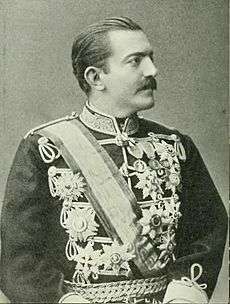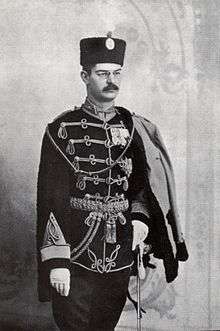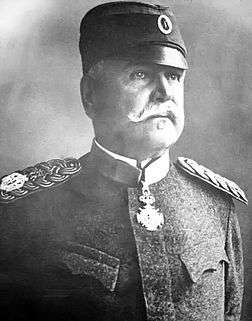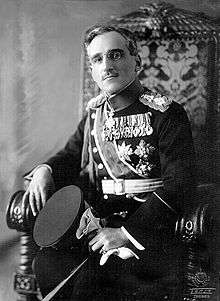Field marshal (Serbia and Yugoslavia)
| Field marshal (Serbian: Бојни Војвода) | |
|---|---|
|
Army service uniform shoulder strap with the rank of Field marshal. | |
| Country |
Kingdom of Serbia Kingdom of Yugoslavia |
| Abbreviation | FM |
| Rank | Five-star |
| NATO rank | OF-10 |
| Non-NATO rank | O-11 |
| Formation | January 12, 1900 |
| Abolished | April 24, 1946 |
| Next lower rank | Army general |
Field Marshal (Serbian: Бојни Војвода or etymologically; Battle Warlord)[1][2] was the highest rank in the army of the Kingdom of Serbia and Kingdom of Yugoslavia from 1901 until end of Second World War in 1945.
It was created with the passing of the Law on the Organization of the Army of the Kingdom of Serbia in 1901. Law was passed on the suggestion of Lieutenant colonel (later Divisional General) Miloš Vasić who was Minister of the Defense at the time. The rank was awarded only during the war for Particular military contributions of top generals.
In the Balkan Wars and World War I this title was used to designate the highest military rank in Serbian Army. The first Field Marshal was promoted by the Great military decree of the Kingdom of Serbia on October 20, 1912. Only four people ever officially held that military rank: Radomir Putnik (got it in 1912), Stepa Stepanović (middle 1914), Živojin Mišić (late 1914) and Petar Bojović (1918). Before this rank was introduced, the highest rank in the Kingdom of Serbia was Army General. After Second World War, newly formed Yugoslav People's Army stopped using Royal ranking system, so this rank ceased to exist. [3]
Insignia of rank
The rank insignia of a field marshal was epolete consisted of braids and in the middle was added two-headed white eagle, the national emblem of the Kingdom of Serbia. In 1923 the design of epaulets remained the same with one amendment, the national emblem of the Kingdom of Serbia was replaced by replaced by the state coat of arms of the Kingdom of Yugoslavia.
Introduction of rank
In late 1897 and early 1898 took place the fracture stages in the development of the army. King Milan return to Serbia, initiated the process of radical military reform. The most important date in the history of the Kingdom of Serbia was December 25, 1897. On that day, King Alexander I of Serbia has signed a two decrees. The first is re-established active Army Command, which was supposed to start work on Saint Sava next year, while other was appointment of King Milan as new commander. On the same day an active Army Command is a military regulation was subordinate to the Ministry of military. In practice, this was not so, because practically active military commander commanded all commands, units and military institutions, a minister of defense has only managed there by deprived of the right to use military force, and he turned into a military administrators. At that time, the first Minister of War was Dragomir Vučković who had the rank of colonel. He formally subordinate to the commander of the active army held the rank of general. When the post of Minister of War set up Jovan Atanacković who had the rank of general, there is a need for the introduction of a new military rank for the active military commander.[4][5]
Former rank
.png)
The change in the structure of the army from 1897 to 1900 year was time when new military ranks where intronduced. The then existing Law on Organization of the Army from 1886 included eight military ranks. Sub-lieutenant, Lieutenant, Captain II class, Captain I class and they were lower officer ranks, while major, lieutenant colonel, colonel and general where were higher officer ranks. At this time new ranks where intronduced warrant officer and army general that was honorary rank. In December 1898, King Alexander I has signed a decree and authorized the then minister of defense to submit it for approval to the assembly. The new command is related to the increase in salaries lower-ranking officers and generals grading rank within: Brigade, Divisional and Corps. This command is not passed with the amendments in national assembly, but for a little more than a year in a modified form, this project is finally realized.[4]
At the XXVI regular session of the National Assembly, following the report of the Military Committee, adopted new amendments to the Law on the organization of the army. Minister Ilija Stojanović during the parliamentary debate, before the adoption of the law emphasized the need for introducing a higher rank than the current staff, the act of army general. According to him, the victim would not be large because the Serbian Army had one, and then in the future two or three. It was clear that the new act is intended active army commander to the King Milan. The opposite opinion was Živan Živanović, who pointed out that the allocation of this act in this case had more political than military significance. This is supported by the aforementioned fact that King Milan, before returning, it is not intended that their military rank, raised by this, but by their desire other military act, which was the title of the Supreme Commander. Therefore, in the summer of 1897 addressed to Stojan Novaković opinion, if anyone other than Karađorđe, was the holder. How Novaković did not know that the founder of the house Obrenović, Prince Miloš was in the Second Serbian uprising, also holds the title of Supreme Leader, King Milan knowing only then that the founder of another dynasty holder of this title, he refused to accept the proposal of this title.[4]
And without this title, the former king has become the holder of the highest military rank in the state, and not only in relation to all the other generals, but also in relation to his son, the then supreme commander of King Alexander I. Decision Assembly, and adopted the draft Law on amendments to the Law on the organization of the army, confirmed King Alexander January 12, 1900. Two days later (January 14), the new act is due to the merit of the two-year work on reforming the Army awarded the King's father. The act was introduced due to the rise of the military rank of King Milan. According to the legislation on the organization of the Army (Article 27), the rank of army general was granted to only by the monarch any general regardless of the time spent in a general's rank. The departure of the King of the Kingdom of Serbia, Milan, gone is the main reason for the existence of this act. General Mihailo Srecković successor as commander of the active army, wasn't promoted to this rank. The new law on the organization of the army from 1901 (Article 7), contrary to earlier, it is not anticipated that the Minister of War in command only performs the tasks laid down in laws and was administrator of army.[4][6]
Field Marshal rank
(1923–1945).]] The new law on the Organization of the army of January 27, 1901, whose creator was then Minister of War, Lieutenant Colonel (later Divisional general) Miloš Vasić, has introduced a new highest military rank in the Serbian army. Field marshal rank brought changes in the general officer ranks. Instead of the previously divided into upper and lower sistem, it was introduced a new category for generals, made up of the two highest rank – General and Field Marshal. The introduction of this act repealed the act of Army General a mark on the epaulets, which previously belonged to the previous act, have been taken as a mark of rank of Field Marshal. According to the law (Article 17), the rank of Field Marshal could only get during the war and it had allocated monarch at its discretion. The new amendments to the Law on Organization of the Army of March 31, 1904, the rank of Field Marshal could get only in war and in him only improve the general who was awarded for successful work. On the first promotion to the rank Serbian army waited eleven years.[4]
First promoted general was Radomir Putnik in 1912, and he was wearing only this rank for two years. Stepa Stepanović and Živojin Mišić were acquired this rank in the space of five months in 1914. Petar Bojović earned rank in 1918 and he was the last Serbian general promoted.[4]
The newly formed army of the Kingdom of Yugoslavia continued the system of military ranks of the army of the Kingdom of Serbia, with small changes. In 1919, former Austria-Hungarian Field Marshal Svetozar Borojević filed a petition over the command in Klagenfurt, to be accepted into a new army of the Kingdom of Serbs, Croats and Slovenes. This request had been rejected as Field Marshal Mišić said that one of the ministers from the Croatia proteseted. On July 19, 1923 a new law on the organization of the army and navy was introduced graduation generals act modeled on the French system of grading: Brigadier general, Divisional general and Army general. According to the law from the regular structure of general promotion Field Marshal was single out and could only get in a war of exceptional merit.[3]
According to the constitutions of the Kingdom of Serbia and Kingdom of Yugoslavia, the supreme commanders wore uniforms with the special Field Marshal insignia. Among them are Kings: Milan I, Alexander I, Peter I, Alexander I and Peter II. Constitution gave permition that in case of war due to the underage of king, deputy Supreme Commander would be Field Marshal active or in reserve.[5]
After the end of World War II, the proclamation of the Federal Republic of Yugoslavia on November 29, 1945 and the establishment of the Yugoslav People's Army on April 24, 1946, adopted the military hierarchy modeled on the Soviet Union with Marshal as the highest rank. This decree abolished all ranks who had previously force is an act of Field Marshal that existed for a full forty-four years ceased to exist.[5]
| Name | Regiment | Image | Born | Died | Date of promotion |
|---|---|---|---|---|---|
| Milan I of Serbia | Royal Family – House of Obrenović |  |
1854 | 1901 | January 14, 1900 |
| Alexander I of Serbia | Royal Family – House of Obrenović |  |
1876 | 1903 | January 27, 1901 |
| Peter I of Serbs, Croats and Slovenes | Royal Family – House of Karađorđević | .jpg) |
1844 | 1921 | June 15, 1903 |
| Radomir Putnik | General staff | .jpg) |
1847 | 1917 | October 20, 1912 |
| Stepa Stepanović | Second Army |  |
1856 | 1929 | August 20, 1914 |
| Živojin Mišić | First Army |  |
1855 | 1921 | December 4, 1914 |
| Petar Bojović | First Army |  |
1858 | 1945 | September 13, 1918 |
| Alexander I of Yugoslavia | Royal Family – House of Karađorđević |  |
1888 | 1934 | August 16, 1921 |
| Peter II of Yugoslavia | Royal Family – House of Karađorđević |  |
1923 | 1970 | October 9, 1934 |
References
- ↑ Rajko St. Micić, war comrade of all Serbian Vojvodas, introduced term Battle, became widely accepted, in order to be distinguished from Četnik vojvoda (which was the rank of guerrilla fighter)
- ↑ Mićić 1923, p. 3.
- 1 2 Bjelajac 2004, p. 15.
- 1 2 3 4 5 6 Milićević 2002, p. 41-59.
- 1 2 3 Milićević & Popović 2003, p. 7-19.
- ↑ Milićević & Popović 1998, p. 24-26.
Sources
- Bjelajac, Mile (2004). Generali i admirali Kraljevine Jugoslavije 1918—1941. Belgrade: Institut za novu istoriju Srbije. ISBN 86-7005-039-0.
- Mičić, Rajko St. (1923). Four Field Marshal's. COBISS 41902087
- Milićević, Milić (2002). Reforma Vojske Srbije: 1897—1900. Beograd: Vojnoizdavački zavod. ISBN 86-335-0112-0.
- Milićević, Milić; Popović, Ljubodrag (2003). Generali Vojska Kneževine i Kraljevine Srbije. Beograd: Vojnoizdavački zavod. ISBN 86-335-0142-2.
- Milićević, Milić; Popović, Ljubodrag (1998). Ministri vojni Kneževine i Kraljevine Srbije: 1862—1918. Beograd: Vojnoizdavački zavod. ISBN 86-335-0035-3.